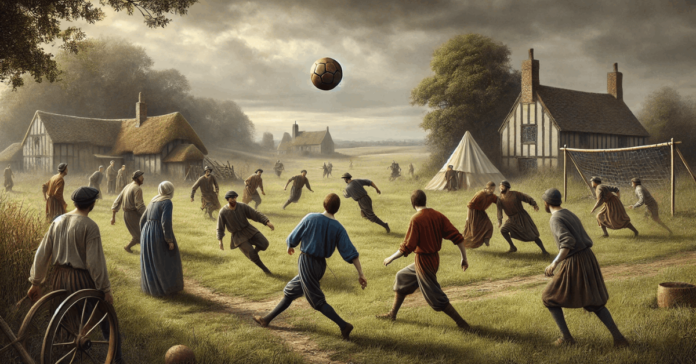
There are different views on the origins of soccer, but one thing is clear: soccer, also called football in most parts of the world, is now the most popular sport globally.
The exact time or place of its invention can’t be pinpointed, but its development can be traced.
Starting from basic ball games and evolving through rugby, soccer grew into the worldwide sport it is today. Here’s how it all began and spread across the globe.
1. The History of Soccer
Soccer’s roots go back to 12th-century England, where a rough game known as ‘Folkball‘ was played.
This version involved kicking but also allowed punching the ball and aggressive tackles. The violent nature of the game set it far apart from the modern sport.
The Ban and Re-emergence in the 1800s
For centuries, soccer was banned in England due to its violent playstyle. It wasn’t until the 1800s that it was revived as a safer winter sport, especially in public schools like Eton and Winchester.
The issue, however, was the lack of consistent rules between schools, as some allowed carrying the ball like rugby, while others did not.
Standardization Through the Cambridge Rules
In 1848, the Cambridge Rules were introduced as the first attempt to unify soccer rules, though they still didn’t settle the matter of handling the ball.
This confusion continued until the founding of the first Football Association (FA) in 1863.
Formation of the Football Association (FA) in 1863
The establishment of the FA in London finally standardized the rules of soccer, clearly separating it from rugby and banning the use of hands in the game.
This was the turning point that shaped modern soccer as it’s known globally today.
2. Industrial Revolution and the Growth of Soccer
The Industrial Revolution significantly influenced the origins of soccer. Factory workers began playing soccer as a post-work activity, forming labor-centered teams.
This period transformed soccer into a social sport played outside of schoolyards.
Rise of Soccer Leagues
The introduction of railroads allowed teams to travel and compete against one another, leading to the formation of the earliest soccer leagues.
Clubs began recruiting the best players and selling tickets for matches, marking the sport’s shift toward professionalism.
Establishment of the First Club
Sheffield became the birthplace of the first amateur soccer club. Initially, cricket players in Sheffield organized casual soccer matches during the winter months.
This eventually led to the creation of Sheffield FC in 1857, the oldest soccer club. Although Sheffield had its own set of rules, the club eventually adopted the official FA rules after conflicts with other teams.
Formation of National Leagues
Soccer’s popularity spread rapidly across England, leading to the formation of the English Football League in 1888.
Soon after, domestic leagues were established in Ireland, Scotland, and Wales, contributing to soccer’s global rise.
3. International Expansion of Soccer
For a long time, soccer was predominantly a British sport. However, the game gradually spread across central Europe and other parts of the world.
In 1889, countries like Denmark and The Netherlands became the first outside of the UK to form their own football associations. Soon after, New Zealand followed in 1891, Argentina in 1893, and Belgium in 1895.
Formation of FIFA
The global popularity of soccer led to the formation of the Fédération Internationale de Football Association (FIFA) in 1904. This organization established rules for international matches to ensure fair competition among different nations.
Although FIFA was founded in France, other key founding members included Belgium, Denmark, Spain, The Netherlands, and Sweden.
Today, FIFA has 209 member countries and is recognized as one of the most influential sporting organizations worldwide.
Early International Competitions
In the early 1900s, the Olympic Football Tournament, part of the Summer Olympic Games, was the most significant international soccer event.
Men’s soccer was included in almost every Summer Olympics since 1900, while women’s soccer made its debut much later in the 1996 Atlanta Games.
The FIFA World Cup
Today, the FIFA World Cup stands as the most prestigious international soccer competition.
It began in 1930, with 13 nations participating, and has grown to 32 teams competing in 2022. The tournament is held every four years, attracting global attention and participation.
4. Asia, Africa, and the MLS
In 1966, FIFA saw the addition of 21 new teams, including those from Asia and Africa. To promote global participation and standardization, new associations were established.
Today, the world is divided into six major soccer confederations.
These include the Confédération Africaine de Football (CAF) for Africa and the Asian Football Confederation (AFC) for Asia, ensuring that the sport’s growth in these regions remains aligned with international standards.
Global Confederations Shaping Soccer
Globally, soccer operates under six confederations.
Besides CAF and AFC, these include the Union des Associations Européennes de Football (UEFA) for Europe, The Confederation of North, Central America, and Caribbean Association Football (CONCACAF), Oceania Football Confederation (OFC), and the Confederación Sudamericana de Fútbol (CONMEBOL) for South America.
These bodies govern soccer development and competition worldwide, contributing to its global appeal.
The MLS and Soccer’s Rise in North America
In 1994, the United States hosted the World Cup, igniting a new passion for soccer in North America.
Following this, Major League Soccer (MLS) was established as a professional Division 1 soccer league in the U.S.
Today, MLS is recognized globally, attracting international stars like David Beckham and Thierry Henry, further boosting the sport’s profile across North America.
5. Soccer Now
Soccer, originating centuries ago, has evolved into the world’s most-watched sport today. Its global reach has influenced the formation of leagues like the MLS.
Though soccer started in ancient times, its influence continues to grow, shaping modern competitions. The MLS’s rise in popularity, aided by innovations like soccer-specific stadiums and the designated player rule, reflects the sport’s deep historical roots.
Soccer’s origins laid the foundation for what has now become a top sport worldwide. Even the MLS has climbed to become the fourth most popular sports league in the U.S., surpassing others like the National Hockey League.
What is The Basics of Soccer?
Historically, soccer developed across various cultures, with early forms found in ancient China, Greece, and Rome. These games shared a common goal—moving a ball towards a target without using hands.
Modern soccer, as it’s known today, originated in England in the 19th century. It established its standardized rules and evolved into a globally recognized sport.
Early Soccer Fields
The early soccer fields were similar to those used today, designed to create a challenging environment for both teams. The rectangular shape and field dimensions allowed for a balanced game where teams could strategize based on field space.
Ancient games used different ball sizes and goals, but the overall objective of scoring remained the same.
Early Roles of Players
In its early days, soccer was played in a less organized manner, but as the sport developed, roles became more defined. The idea of having specific player positions, such as attackers and defenders, can be traced back to the sport’s origins.
Teams would often form strategies around their players’ strengths, leading to the formal positions seen in modern soccer.
Key Terminologies of Soccer
The origins of soccer shaped many of the key terms used worldwide in the sport today. These terms trace back to the game’s early days, and understanding them gives insight into how soccer evolved globally.
- Goal: From the start, scoring goals has been the objective of soccer. The act of kicking the ball into the opponent’s goal became the defining moment of victory.
- Assist: Assisting a goal was recognized early on as an important part of teamwork in soccer. This concept of one player setting up another for success can be traced back to the game’s foundations.
- Penalty Kick: The idea of a penalty kick originated as a way to maintain fairness in soccer. Early games saw the introduction of this rule, giving teams a chance to score when a foul was committed in a critical area.
- Red Card: Red cards, representing serious violations, became part of soccer’s disciplinary system as the sport formalized globally. Players removed from the field for dangerous play were part of the early rules designed to keep the game safe.
- Yellow Card: Yellow cards emerged as a warning system for minor offenses. This system evolved as soccer grew in popularity and spread worldwide, ensuring fair play and order throughout the game.
Conclusion
In conclusion, soccer has a deep historical foundation, originating from ancient communities. Over time, the sport has evolved, yet it remains a significant part of global culture.
Soccer unites people worldwide, whether in stadiums or on television screens, maintaining its relevance across generations.






